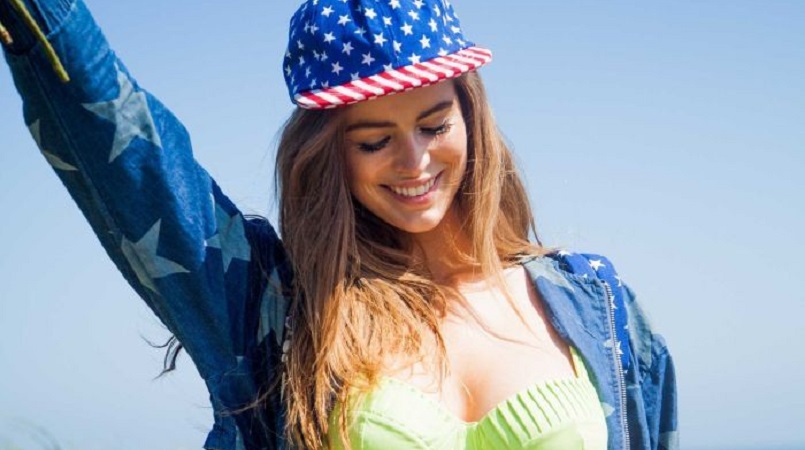
Australia's most successful plus-size model has hit back at criticisms some curvy models who appeared in a Sports Illustrated catwalk show sent an unhealthy message.
At size 14 and 185 centimetres, former Sydneysider Robyn Lawley said it was time an array of sizes were shown on runways.
"These are people we're talking about. They have feelings," Lawley said.
"I've met all the girls who did that catwalk. None of these models were unhealthy … they all work out."
NSW Australian Medical Association president Dr Brad Frankum last week claimed the use of unhealthily overweight models was, "sending a message that it's OK to be obese or severely overweight because it's the normal state of being but in fact you are putting yourself at risk".
Dr Frankum's comments fired up debate on social media with one woman asking him to "please stop criticising obese people" and another woman saying she was "disgusted".
A number of curvy models paraded down the catwalk at Miami Swim Week — the first time the swimwear magazine had used models who were classified as plus-size.
They were finalists in a contest vying for a photoshoot in an upcoming swimwear edition.
After a successful career as a model and now as a photographer, Lawley said she was "super excited" to see curvy girls on the runway, adding there was "a vast array of sizes, heights and ethnicities" at the Sports Illustrated show.
Lawley, who has made it her mission to promote diversity on the runway, has spoken out after Dr Frankum's comments, in which he also labelled the runway show as "dangerous".
In 2015, she was the first plus-size model to feature in an editorial spread for the swimwear bible and has been involved in behind-the-scenes filming for previous runway events.
Obese models likened to smoking on the runway
Despite the backlash, Dr Frankum has stood by his comments ahead of tonight's Australian Story on Lawley and body image within the fashion industry.
"Weight is such a sensitive area," he said.
"For a long time, being overweight wasn't discussed at all because people felt embarrassed but if we ignore this it's going to get worse."
Dr Frankum also welcomed a more diverse range of body sizes on the runway, but warned promoting severely overweight or obese models justified and normalised something unhealthy.
He likened the use of obese models to a model smoking a cigarette walking down the runway.
"It's sending a message that it's OK to be obese or severely overweight because it's the normal state of being but in fact you are putting yourself at risk," he said.
Speaking from her home in upstate New York, Lawley said women should see themselves represented, no matter their size.
"Only five years ago, people were shocked to see me walking down the runway," she said.
'This is what many of us look like'
Lawley's successful career as a plus-size model is proof of how much the fashion world has changed in the past decade.
As a teenager from Sydney's western suburbs, Lawley was on the verge of abandoning her dream of becoming a model because mainstream agencies told her she was too curvy.
But after signing with plus-size agent Chelsea Bonner at the age of 19, Lawley went on to achieve a number of fashion firsts: she was the first curvy model to appear in Italian and Australian Vogue and the first to be signed by designer label Ralph Lauren.
Plus-size models have become increasingly popular in recent years, here and overseas.
They are now appearing in ads for high-street fashion labels such as Showpo and Birdsnest in Australia and Calvin Klein and H & M in the US.
Sydney-based Bonner also dismissed Dr Frankum's comments, saying it was not fair to make broad statements about someone's health based on a photograph.
Bonner claims the only reason people are shocked by larger women parading swimwear is because they are not used to seeing them next to size-6 models.
"It shouldn't be a shock … that's what many of us look like," she said.
Bonner has for years been trying to persuade the fashion industry to use a broader range of models in advertising, arguing it should better reflect the fact the average size of Australian women is 14–16.
"We wouldn't represent a size-6 model if we knew she had health issues and we wouldn't represent a size-16 model if we knew that either," she said.
But even Bonner is concerned certain labels are hiring the more extreme end of plus-size models for shock value.
"There's a trend for some designers to use very large models to get press," she said.
Lawley says she is now at risk of losing modelling jobs because she is too slim — a downside to a career built off plus-size modelling.
At a recent casting in the US, Lawley said she was told: "I wasn't enough of a statement. I wasn't curvy enough … that's what's happening now. They want the curviest, the biggest, the tallest."
Both Bonner and Lawley look forward to the day when the term "plus-size" is no longer used for models over a size-10.
"I've always been the person who says I hate the term plus-size," Lawley said.
"I hate the tag. I think you should shoot a whole bunch of girls, whatever size you need."
Watch Australian Story's 'The Shape Shifters' 8pm on ABC TV and ABC iview.
